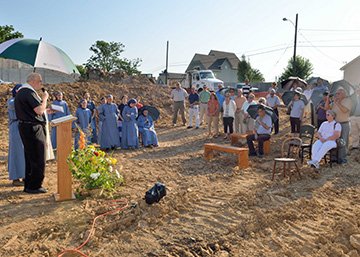
Leaven photo by Jill Ragar Esfeld Archbishop Joseph F. Naumann joined the Little Sisters of the Lamb for a groundbreaking ceremony with members of the Kansas City, Kan., community they serve. The Sisters are hoping to raise $250,000 by April 1, 2013, in order to match a challenge grant from the Mabee Foundation of Tulsa, Okla.
By Jill Ragar Esfeld
Special to The Leaven
KANSAS CITY, Kan. – “I asked the Sisters once, ‘Why did you move here?’
“They said, ‘Because this area needs us.’
“I said, ‘Because you see decay and crime here?’
“And they said, ‘Yes.’”
Martin Thoennes, executive director of the Central Avenue Betterment Association, recalled this conversation as he reflected on the changes he’s seen since the Little Sisters of the Lamb moved into All Saints Parish in Kansas City, Kan.
The story of the caterpillar becoming a butterfly aptly illustrates these mendicant nuns and their impact on this neighborhood.
But they are not the caterpillar or the butterfly.
They are the cocoon, becoming one with the poor and surrounding them in God’s love until a transformation begins.
“I believe they’re accomplishing something many other organizations have tried to do,” said Thoennes. “They’re bringing the word of God into homes.
“And they’re being received.”
Lumen Christi, Light of Christ
The Little Sisters moved to Kansas City, Kan., four years ago at the request of Archbishop Joseph F. Naumann.
Last month, the archbishop blessed workers starting construction on the first Community of the Lamb monastery in North America — a permanent home for the Little Sisters, which they have named “Lumen Christi.”
As a branch of the Dominican order, the Little Sisters live out their charism, or mission and spiritual orientation, in contemplative prayer and evangelical poverty. They rely solely on divine providence and charity for their living.
Like the children Jesus extolled in the Gospels, their goal is to receive the word of God in docile humility and carry it with them as they go out into neighborhoods each day begging for their daily bread.
“They walk all around Wyandotte County,” said parishioner Hortensia Cera, who has lived in the area for 30 years. “A lot of people know them now.”
Indeed, people open their homes to the Little Sisters, share food with them and, in return, they experience God’s love in word and music — the Little Sisters are known for their harmonious voices and prayerful songs.
“It so beautiful,” said Cera. “When they are singing, I feel like I am on the clouds.”
All Saints parishioner Ann Dercher has lived in the neighborhood for 74 years and is head of the neighborhood association.
She’s watched in awe as the area has taken on new life in the wake of the Little Sisters’ footsteps.
“They mingle with the neighbors, and it brings a closeness to the neighborhood,” she said. “I really enjoy seeing that.
“They let the neighbors know, ‘We’re available if you want to talk with us.’”
“And so they become our brothers,” said Little Sister Martine of her new neighbors. “They are not the poor, they are John, Peter, Amanda — our friends.
“And, from this friendship, they listen.”
God loves them, too
Terry Sexton and his wife Michelle, parishioners of Curé of Ars Parish in Leawood, are lay members of the Community of the Lamb and often visit the Little Sisters.
Through them, the Sextons and many other Johnson County families have built a bridge to fellow Catholics in the inner city, and friendships have been formed.
“The Little Sisters’ presence among the people in that neighborhood signals to them that they are important,” he said. “That God loves them, too.”
He loves them so much, in fact, that there’s no need for despair.
“Don’t despair,” said Little Sister Martine. “The Lord is helping us. Why wouldn’t he help you?”
God loves them so much, there is no need to worry about tomorrow.
“Tomorrow, God knows,” continued the Little Sister Martine. “He knows that we need to eat and to have shelter. So we are a concrete sign of the bounty and the mercy of God.
“So if it’s true for us, it’s true for everybody.”
And the neighborhood is beginning to show signs of sharing the trust in divine providence that the Little Sisters model.
“The Sisters confirmed their presence by not being afraid and by not shutting themselves up,” said Thoennes. “What I’ve seen primarily is the belief in the children that they’re safe because they see the Sisters walking.
“And I see the ladies of the households light up when I talk about the Sisters.”
”I don’t know how to explain it,” added Dercher. “It seems like they have occupied a vacant space here.”
With gentle humility, the Little Sisters make themselves visible and available to their neighbors.
“We had a day when we met a lady in the street,” said Little Sister Stephanie. “We didn’t know her, but she knew us — she’d watched us going in and out of the house.
“She said that she had been involved with ‘bad stuff.’ And she said, ‘Sisters, your presence is very special to us because you remind us that we should not follow the evil one.’
“Then she said she would go back to church.”
She’s not alone. Many of the neighbors have begun to join the Sisters in their daily prayer — too many for their current makeshift chapel to hold.
That will be remedied in the new monastery
“The chapel will be much bigger than just for the Sisters that live there,” explained Little Sister Stephanie. “Right now, we always have to figure out how many can fit in our chapel before sending out invitations.
“We look forward to being able to invite everybody so all can join in prayer.”
Giving from the heart
Proof of the neighborhood’s enthusiasm for the monastery is seen in its effort to help the Little Sisters raise funding, even though many of the local residents have so little to give.
One neighbor worked hard to get scrap metal out of the old rectory and sold it, giving the money to the Little Sisters.
Because Cera couldn’t give much on her own, she took up a collection at work.
“I told the Sisters to make me some letters to give in my job,” she said. “I put them in an envelope and gave them to the employees.
“But I had to do that in my lunch time. That’s what I did for them.”
The Sisters are deeply grateful for every donation, especially those given from the heart.
“The Little Sisters will get checks from wealthy donors,” said Sexton. “But I know what means the most to them are the small gifts from the people who are digging deep.”
“They say, ‘If somebody gives us a penny, it’s good to us,’” added Cera.
Indeed, the pennies add up. More than 2500 donors have contributed to raise enough money for construction to begin.
As a symbol of their appreciation, and an acknowledgement that the donors are the foundation of their monastery, the Little Sisters have a special plan.
“We will put the donors’ list under the foundation,” said Little Sister Stephanie. “We will just put all the names, not the amounts, of all those who have donated money or labor — all those who are part of this project.”
It’s not too late for donors to get their names on that list.
The Little Sisters are finding that, though their monastery design is very modest, meeting building codes and regulation in the United States makes it expensive to build even a simple structure.
“We have to compromise with ‘Mr. Code’ who is very demanding,” explained Little Sister Martine. “And so it’s a fight to build something that is simple, beautiful.
“For example, for the safety, they ask for things we never had in the monasteries in Europe — like fire alarm systems and sprinklers.”
An important milestone was reached recently when the Mabee Foundation of Tulsa, Okla., issued a challenge grant of $390,000 toward the $2.1 million dollar cost of building.
However, an important aspect of the Mabee grant is that the Little Sisters need to raise the final $300,000 needed to fully fund the project by April 1, 2013.
“If this fundraising goal is not met by that date,” said Sexton, “the Mabee challenge grant will be forfeited!”
How to help the Little Sisters of the Lamb
The Little Sisters received a challenge grant from the Mabee Foundation of Tulsa, Okla., for $390,000. It is critical that they raise their matching amount by April 1, 2013, or they must forfeit their grant.
The people they serve are poor. So they are issuing a plea to all Catholics in the archdiocese: “At this time, we need to raise an additional $250,000 to allow us to bring the project to completion.”
You can send your donation or pledges to:
The Little Sisters of the Lamb
801 Vermont Ave
Kansas City, KS 66101
Or, you can donate online by visiting the website at: http://www.communityofthelambusa.org.
You also can visit the website above to learn more about the Little Sisters and to view a model of the Lumen Christi Monastery.






